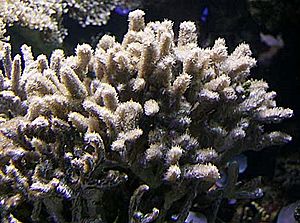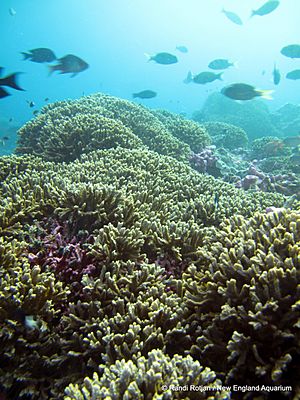Hydnophora rigida facts for kids
Hydnophora rigida is a type of coral often called horn coral. It lives in coral reefs. A scientist named Dana first described it in 1846. This coral can be green, brown, or cream. It can even glow bright green or reddish-blue!
Quick facts for kids Hydnophora rigida |
|
|---|---|
 |
|
| Conservation status | |
| Scientific classification |
Contents
About Horn Coral
Hydnophora rigida is one of the most common types of Hydnophora coral. People also call it spine coral. It was first described by Dana in 1846.
Where Horn Coral Lives
This coral is often found in shallow reef areas. You can see it around Australia and the Philippines. It also lives in Fiji, Indonesia, and Samoa. Other places include the Solomon Islands, the Great Barrier Reef, and the Coral Sea. It can even be found on the east coasts of Africa and near Madagascar. H. rigida likes to live in calm lagoons and protected parts of reef slopes.
What Horn Coral Looks Like
H. rigida has thin branches. These branches are usually cream or green. This coral can also glow green or reddish-blue. You can find it in water from 1 to 30 meters (3 to 100 feet) deep.
The coral colonies look like bushy plants. They have small cone-shaped bumps called monticules. These bumps are special because they form where the walls of tiny coral polyps join together. The polyps around the base of these bumps might look brown. Their color can be a bit different from the rest of the coral. At night, these polyps can extend their tiny tentacles.
How Horn Coral Reproduces
Horn coral colonies release their eggs and sperm after the full moon in November. This coral is a hermaphrodite, meaning each coral has both male and female parts. The eggs develop earlier than the sperm. Scientists think that many H. rigida colonies can have several reproduction cycles each year.
Spawning Season
In the Houtman Abrolhos Islands, coral colonies had ripe eggs in March. This suggests they are part of a big spawning event in western Australia. Researchers found that H. rigida was ready to reproduce from November to February. This means their spawning season might last for several months each year.
This coral releases its eggs into the water. This makes them "broadcaster spawners." Their eggs are quite small, about 220 micrometers. This small size is another sign that they might spawn more than once a year. Most other coral species usually spawn only once a year.
Scientists also found that most colonies had ripe eggs before the full moon in November. They had ripe sperm around the full moon in November. Fewer fertile colonies were found in December. Because they spawn in November, scientists think they might also spawn in March. This would be a separate spawning time.
From Egg to Coral
After an egg is fertilized, it forms a tiny larva called a planula. This larva then settles onto a hard surface. It becomes a tiny "planter." Then, it starts to form small polyps. These polyps create calcium carbonate, which is the hard material that slowly builds up the coral colony.




